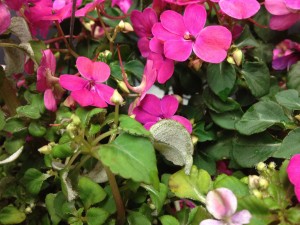by Francesca Peduto Hand and Nancy Taylor
Department of Plant Pathology The Ohio State University pedutohand.1@osu.eduIn the last seven to ten days there have been several reports of impatiens downy mildew’s appearance in the midwest; as of this time we have two reports from Ohio. The pathogen that causes the disease, Plasmopara obducens, is extremely aggressive on bedding plant impatiens and Ohio’s impatiens producers should be aware of and scouting for this disease.
Growers should already be utilizing a preventive fungicide schedule as recommended by the floriculture industry. For those growers who are not already on a treatment schedule or those who adopted a wait and see approach, now is the time to implement preventive treatment! But first, discard any plants that are showing symptoms, they cannot be cured and are producing inoculum to infect additional plants.
Symptom description: The earliest symptom may be a slight curling or mottling of the foliage and symptoms may be subtle. Under high humidity the pathogen will become visible producing its sporangia, resulting in a heavy coating of white sporulation on the underside of the leaves (Fig. 1). The fungus sporulates prolifically; one grower described white dust floating above the plants when they were disturbed.
How to scout: Pay particular attention to early symptoms. At an early stage, sporulation might not be present and most likely won’t be observable in warm and dry conditions. Look for a slight chlorosis (light green-yellowing) and downward curling of the leaves. Periodically turn leaves over to look for white sporulation, especially under conditions of high humidity. Contact your local extension specialist or diagnostic lab for assistance with diagnosis.
Preventive treatment: Management of this disease must focus on prevention. Minimize humidity and leaf wetness, aiming for RH <85% and leaf wetness periods of <4 hours. Provide good air circulation by spacing plants and using horizontal airflow. Avoid condensation on the leaves by confining irrigation to when leaves will dry quickly. Remove symptomatic plants and any fallen leaf from the greenhouse as early as possible inside sealed bags, together with nearby Impatiens spp. A list of available fungicides for preventive treatments, not intended to cure already diseased plants, can be found at:
http://endowment.org/images/stories/AFEnews/diseasepreventionschedule.pdf
http://endowment.org/images/stories/research/imp%20dm%20program%202.pdf
Floriculture researchers at Ohio State University are interested in measuring the impact of this disease in 2013. If you see the disease you may send a diagnostic picture along with information regarding your address and the extent of the problem to ppdc@osu.edu.
Or you may send a sample to the diagnostic clinic where it will be examined at no charge:
C. Wayne Ellett Plant & Pest Diagnostic Clinic
Ohio State University
8995 E. Main St., Bldg. 23
Reynoldsburg, OH 43068
Phone: (614) 292-5006

